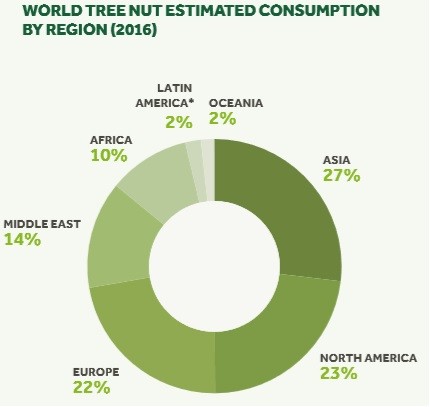Planning for the long game: Macadamia trees are a 20 year investment
https://www.agtag.co.za/category/14/post/20862September
South Africa’s industry could be underprepared for the future macadamia market. Most of our nuts go to China, while Asia represents only 27% of the global tree nut market.
September 2018
Farming and establishing macadamia orchards is a long term investment. Trees take four to seven years to reach optimal yields, which tend to grow in size as the tree matures over the years, depending on management and cultivar performance by region.
‘It would be remiss of us as an industry to assume that what got us here today is going to get us to where we need to be in ten or even 20 years. Market demand has fundamentally shifted and there are significant changes in what customers, from the US, Europe and China, want on the horizon,’ said Alex Whyte, general manager, Green Farms Nut Company.
Defiant of simple economic principle, the nut sector in general, and macadamias more specifically, are in the unique and prosperous position where both supply and demand is on the up. Largely attributable to growing populations and momentous changes in healthy and ethical eating. Additionally, for a variety of reasons, Asia increasingly demands larger nuts. Requirement within the ingredient sector, for diced product is on the rise globally.
The range of macadamia tree cultivars available each yield different nut sizes (commonly named style 0, 1, 2, 3, 4 from largest to smallest), sound kernel recovery ((SKR – the nut to shell ratio) and volumes depending on a number of factors from region to region.
This becomes significant through the lens of South Africa’s current export market mapped to global consumption. Leading South African nursery, selling over 500 000 macadamia trees a year, Red Sun Hortitech director, Mark Hassenkamp, has crunched the numbers on suitability of the South African crop for the years to come: and they’re worth paying attention to.
‘Global tree nut consumption has increased 24% over the last ten years. This, alongside the astonishing 473% increase in their value over the same period of time makes it understandable that focus has been on the here and now. However as the market continues to mature and crop volume grow, specific demands for quality and nut grade is going to have a consequential impact,’ said Hassenkamp.
It is estimated the 50% of macadamia trees that have been planted in South Africa are of the 695 variety, also known as Beaumonts. They are popular in that they are relatively easy to cultivate, are fast growing with typically large yields, tend to produce a smaller nut and are more difficult to crack due to their lower SKR ratios (less shell to nut by comparison to other varieties). The 56% of South Africa’s crop exported to China are mostly Beaumont variety nuts.
20% of trees going into the ground are the A4 variety, which usually deliver good sound kernel recovery and larger nuts. Another 20% are 816 variety and the remaining 10% a mix of 849, 814, 842 and others.
The graphs below articulate South Africa’s (currently the world’s largest producer) export destinations alongside key global demand regions: 56% of South Africa’s crop goes to China, although the Asian market represents only 27% of global tree nut consumption. Reports that China’s domestic crop is set to grow exponentially over the next few years indicate they will serve a large portion of their demand provided through their own crop.
‘Driven by aggressive demand and low levels of compliance in the past, the Chinese market will over the longer term stabilise. And as part of this process 2018 has again faced some uncertainty within this region. Chinese buyers have not been as proactive as in the past in procuring product and have little interest in small in-shell sizes. Increasingly this market becomes more discerning and with demand shifts,’ said Whyte.
Both Whyte and Hassenkamp share the view that in percentage terms the spread of global nut consumption is unlikely to change (as per Figure 2). However actual consumption is projected to stay on the rise.

Figure 1: South Africa export destinations (source: SAMAC 2018)

Figure 2: Estimated world tree nut consumption (source INC 2018)
‘From a marketing perspective, we would be wise to cultivate relationships, market access and scope in the US and Europe. Our marketing business, Green & Gold Macadamias, is also proactive in creating the right opportunities through our marketing efforts to absorb nut pieces into the ingredients sector,’ said Whyte.
Green Farms Nut Company continues to place strategic emphasis to support changes in demand for size, quality, safety and traceability. We work closely with our processor partner network and Green & Gold Macadamias, to ensure capability spans improved cracking technology and value add facilities,’ said Whyte.
‘My advice to farmers is to plant a well balanced spread of cultivars based on careful benchmarking of region and farm specific analysis to ensure you’re well hedged for future demand. It’s not just about what’s profitable now – it is about what is sustainable and expected from markets in ten years from now. A combination of volume and value is paramount: the dynamic of yield and crack out interplay of sound kernel recovery of macadamia yields achieved is specific from farmer to farmer,’ concluded Hassenkamp.